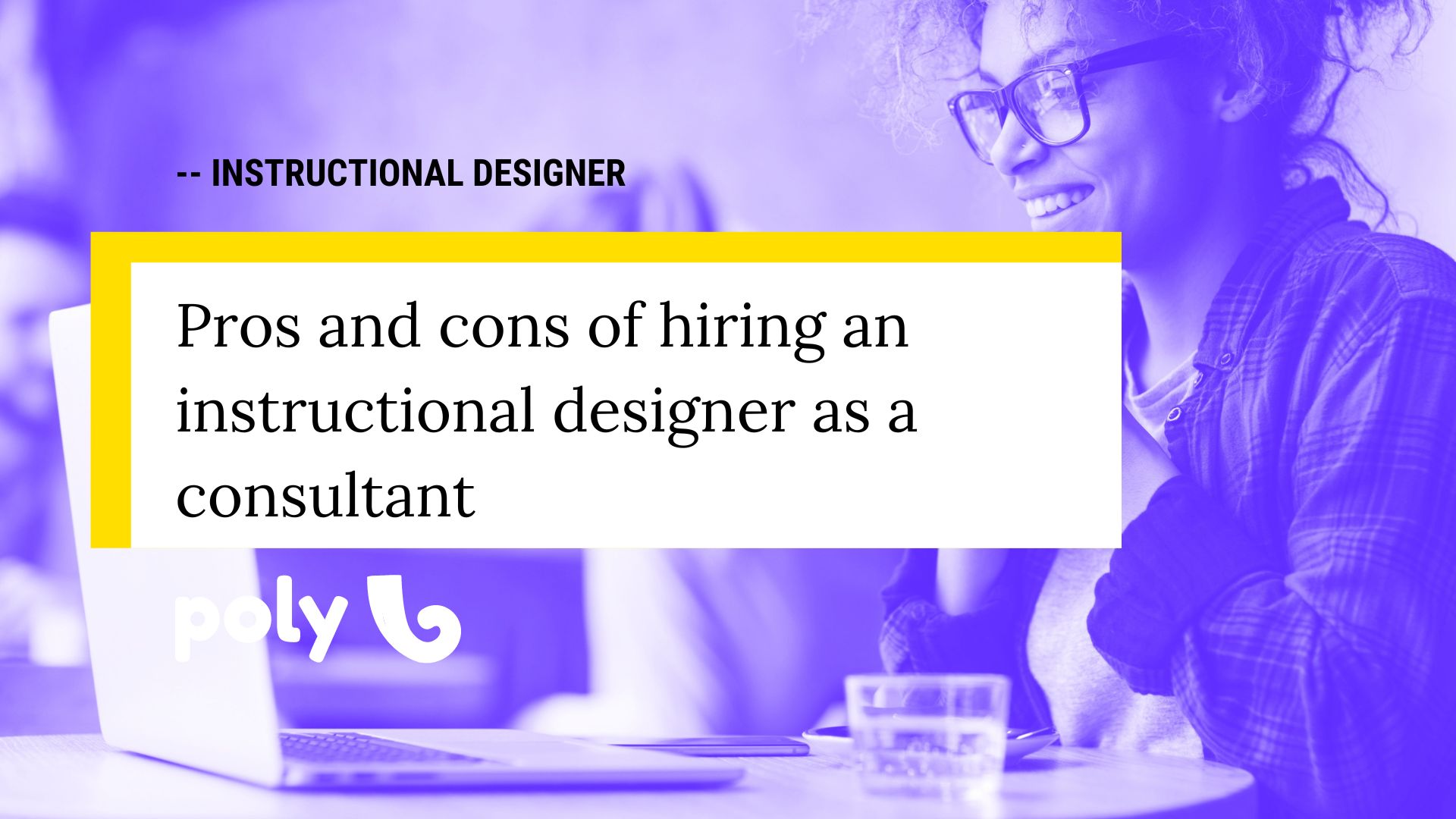Pros and cons of hiring an instructional designer as a consultant
The independent contractors’ industry offers an incredible amount of unique talent when it comes to hiring instructional design experts. The gig economy (that’s what they call it out there) has taken off, providing freelancers with more lucrative and diverse opportunities.
In 2021, 36% of the American workforce are freelance, which includes those hired as independent contractors. And the field of instructional design is no different.
The freedom to work remotely has helped transform the job market for the better. There are more options for those who are bored with the 9-to-5 grind and commuting. Moreover, many professionals have realized that they can earn more, have a better quality of life, and even dedicate more time to their personal dreams.
When you need to fill an open instructional design position, consider looking for individuals who aren’t seeking traditional employment (like being on the company payroll). You will likely have a better chance of finding highly qualified professionals since they have more control over their careers and lives.
If you’d like, you can post your instructional design job ad with Poly Academy to attract the best talent. It’s free.
Let’s discuss the pros and cons of hiring a freelance instructional designer for your open position.
The Pros of Hiring an Instructional Designer as a Consultant.
If you’re struggling to decide whether hiring an instructional designer as a consultant is the best path for your company, make sure to read through the pros of doing so in this section.
Better use of resources.
Every company wants its employees and contractors to use their time and resources best. You can streamline the recruitment process when hiring a freelance instructional design candidate.
Interviews are not scheduled in person but can be conducted via video calls. Contract signing, NDAs, and non-competes can also be done digitally. This saves time and money for your company.
Furthermore, if you have a third-party contractor like Poly Studio, you can have access to a team at a much lower cost than hiring a full-time employee, considering taxes and benefits. Nowadays, an experienced and competent instructional designer won’t accept a salary lower than $9,000. With that amount, you can hire an entire team at an instructional design agency.
In addition to having the most skilled instructional designer in the market, you’ll also have access to a broader range of skills, which is incredibly rare to find in a single person. Developers, graphic designers, and individuals with extensive experience in LMS, corporate training, curriculum development, educational objects, etc.
Finding high-performing candidates in their fields.
We don’t have statistics on this but think about it from this perspective: a high-performing instructional designer will either be well-employed or have a company. Of course, some actively seek opportunities, but they make up a small fraction.
Therefore, competing to attract specific talents for your project can be financially costly and time-consuming.
By directly reaching out to freelancers, you can be certain to find highly competent professionals with relevant experience for your project.
Reduction in overall costs.
When a company hires a freelance instructional designer, it will see a reduction in overall costs. The company doesn’t need to pay the freelancer a fixed salary or provide health benefits or other financial perks. All that needs to be done is to negotiate a price for the project in stages or as a whole. This offers a much greater return.
Flexibility.
One of the biggest pros of hiring an instructional designer as a consultant is their flexibility. Freelancers are generally flexible in everything they do because it helps them succeed in their careers.
They have the ability to handle multiple clients and projects simultaneously. If you need a highly flexible worker who can adapt quickly, a freelancer can help your company.
For example, here at Poly Studio, we practice hourly projects, which allows for changes in the project along the way. This has proven to be much more advantageous for our clients, who have the freedom to make any changes to the project scope—and for us, as we don’t stress about having to redo budgets and project specifications with every change.
The cons of hiring an instructional designer as a consultant.
Like with any investment, you need to look at both sides of the story, and that’s why we’re now going to present the cons of hiring a freelance instructional designer for your open education position at your company.
You don’t know how to deal with suppliers.
Probably one of the strongest cons of hiring an instructional designer as an Independent contractor is that they are a supplier, not an employee. This requires a different approach, from meeting deadlines to scheduling meetings and, of course, how you handle things.
While few companies often have a bad habit of mistreating even their employees, a competent instructional designer aware of their skills won’t accept that kind of treatment. Working as a contractor teaches us to value our clients and understand the types of clients we want to work with.
There’s also the comparison factor: after all, while an employee deals only with your company, a contractor probably has multiple clients, so they’re more likely to have benchmarks for what makes a good client and a bad client.
Remember: they’re a supplier, not an employee.
Your company doesn’t have a remote work culture.
It can lead to conflicts if your company doesn’t know how to handle remote work or asynchronous communication.
Remote work requires specific skills and knowledge, like assertive asynchronous communication (quite different from synchronous communication, for example), conducting follow-ups and remote meetings, and project and task management.
A leader who is not used to remote work will have to go through a learning curve. Make an effort to learn how to work remotely, and you’ll unlock an incredible talent pool!
The professional will have greater limits on their scope of work.
While with an employee, it’s a sad reality and practice to extend the work beyond the job description, they’re more likely to impose more limits when hiring an instructional designer as an independent contractor. For example, having well-defined working hours (or at least communication hours) and not accepting additional tasks.
All of this will, of course, be specified in the contract. While many people think it’s easier to ask for extra things from contractors, good and competent professionals will have more confidence in not accepting that kind of demand or at least renegotiating the contract.
Moreover, it’s important for both parties to discuss knowledge retention, such as documentation and guides for future reference. Many companies not used to dealing with contractors may fear not retaining knowledge, while those accustomed to it know how to demand and negotiate.
At Poly Studio, it’s our practice to document everything. In fact, we have a knowledge base that our clients have access to so they can operate everything we do on their own.
The professional won’t have a deep understanding of your company’s routine.
It’s important to know that a major downside of outsourcing work is that the professional is not immersed in your company’s culture and routine. While culture doesn’t hinder the progress of the project and the execution of work according to the guidelines, you’ll always be reminded that you’re dealing with an outsider.
Additionally, it’s important to keep the professional updated on changes and relevant strategies and provide feedback on their performance. The contractor probably doesn’t participate in daily meetings with each member of your team, so it can be difficult for them to stay updated on every aspect.
Hiring an instructional designer as a consultant can be the best alternative.
There are pros and cons to everything in life. Make sure you look at both sides before making a decision to hire Independent instructional designers. We’ve tried to address both sides, but we definitely have a conviction about which is better here, don’t we?
While internalizing our work can be great for larger teams and when education is at the core of your business, it rarely makes sense to internalize this type of role if it’s a project for your company.
Count on Poly Studio to clarify your concerns openly and honestly if necessary.







